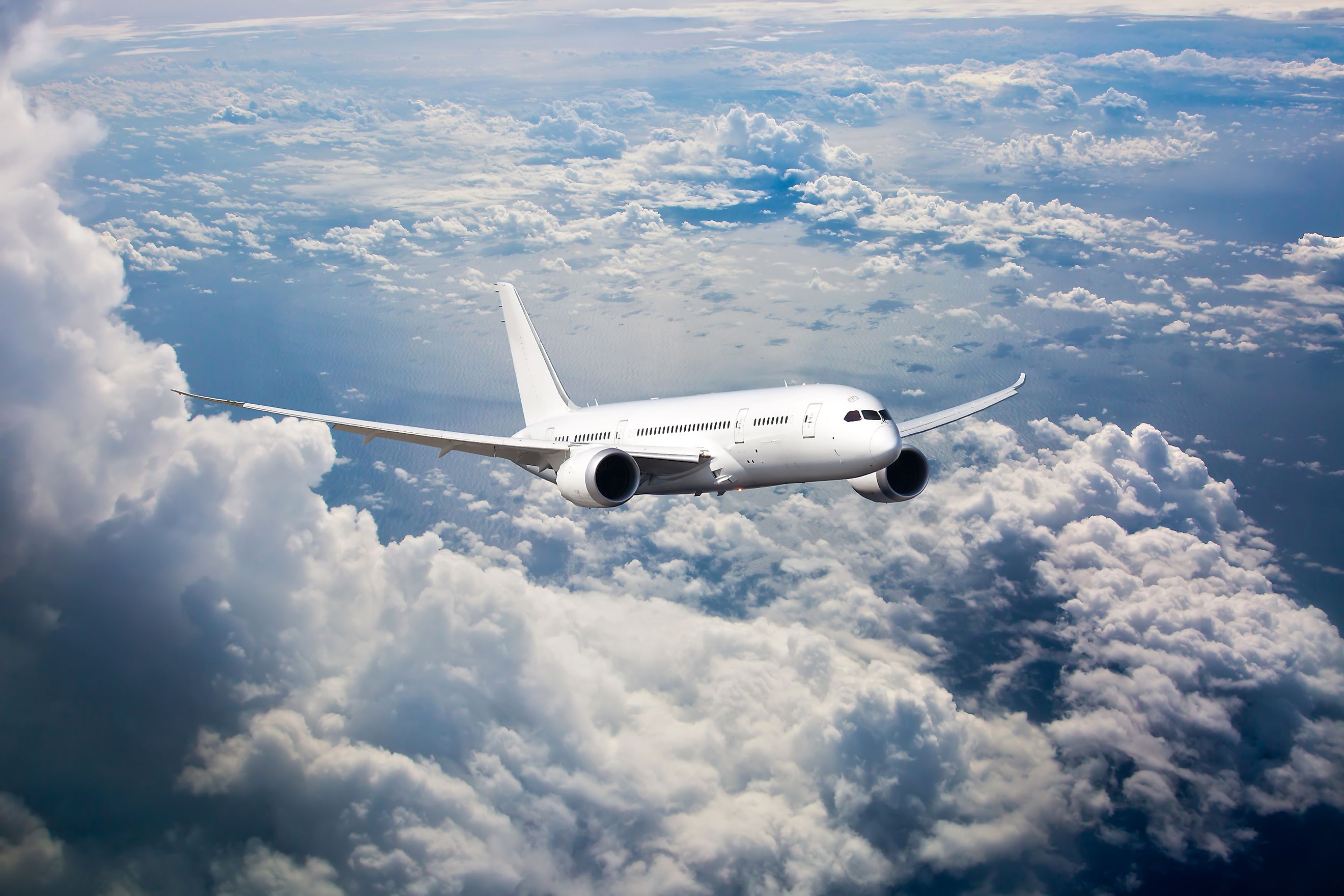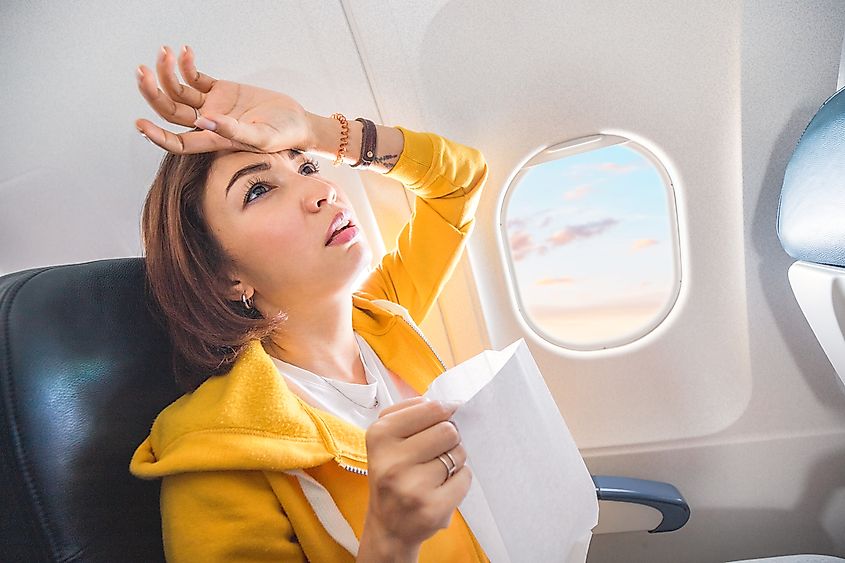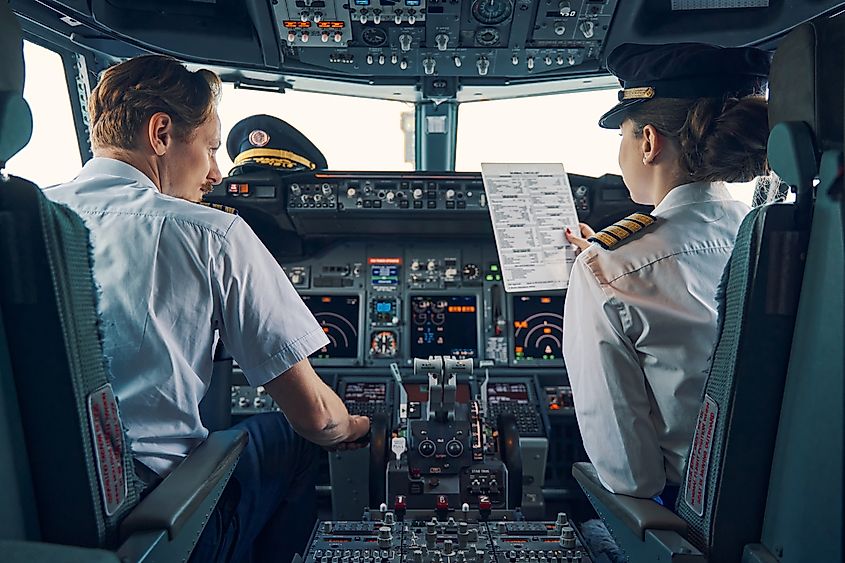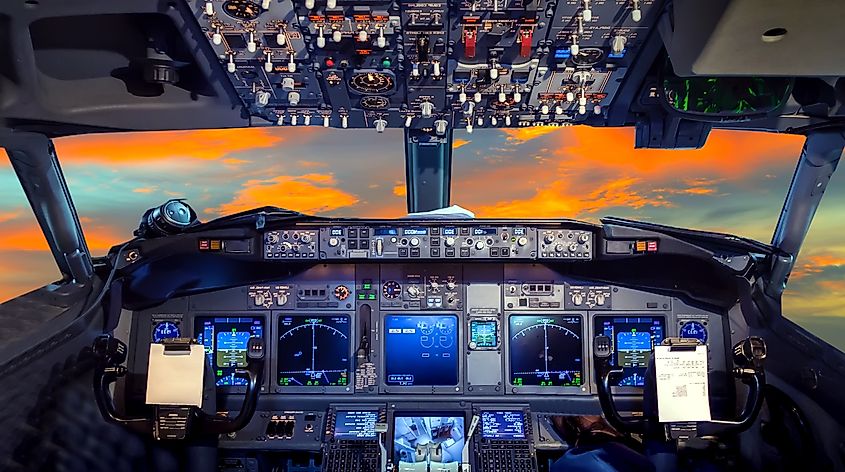
11 Most Turbulent Flight Routes In The World
Turbulence occurs when an aircraft encounters a strong gust of wind that can push or pull the craft, often experienced as bumpiness. In severe instances, turbulence can be as intense enough to throw the plane out of control momentarily. Understanding turbulent routes can help travelers prepare better for potential changes in travel plans, especially on short notice, and help them cope during the flight experience. Being knowledgeable about turbulence as a traveler can help ease any anxiety and reservations and make for a more comfortable experience.
What Causes Turbulence?
One of the most unpredictable weather phenomena, turbulence, can be caused by a series of factors. Turbulence most often occurs when the aircraft encounters colliding wind movements within clouds. Unless the craft is flying through larger clouds, the effect is typically mild. Thermal turbulence, caused by hot rising air typically from cumulonimbus clouds, is more common in characteristically warm areas or warm seasons. Mechanical turbulence is caused by deflected air masses moving across the landscape. The changes in landscapes, such as mountains or skyscrapers, will distort the airflow in the sky above them. Global weather systems also impact turbulence and are a frequent cause of turbulent air in the atmosphere. Clear Air turbulence, however, is cloudless and invisible and often occurs around the Jetstream, where friction between slower and faster air creates turbulence. The jet stream is always present and constantly moving and changing. The frequency of turbulence during flights is increasing due to climate change, which intensifies the effect of the jet stream. Airplanes themselves can also create turbulence, known as wake turbulence, which affects planes that fly below or behind the original craft. The bigger the plane, the more wake turbulence it creates.
Turbli, a turbulence forecasting firm, analyzed 150,000 routes, scaling the turbulence for each route with an eddy dissipation rate (EDR). Light turbulence levels range between 0 and 20; moderate turbulence ranges between 20 and 40; severe turbulence ranges between 40 and 80; extreme turbulence ranges between 80 and 100.
The Most Turbulent Flight Routes in the World
- Santiago, Chile to Santa Cruz, Bolivia
- Almaty, Kazakhstan to Bishkek, Kyrgyzstan
- Lanzhou, China to Chengdu, China
- Centrair, Japan to Sendai, Japan
- Milan, Italy to Geneva, Switzerland
- Lanzhou, China to Xianyang, China
- Osaka, Japan to Sendai, Japan
- Xianyang, China to Chengdu, China
- Xianyang, China to Chongqing, China
- Milan, Italy to Zurich, Switzerland
- Nashville, Tennessee to Raleigh/Durham, North Carolina
Santiago, Chile to Santa Cruz, Bolivia

Aerial view of the Andes Mountains landscape.
It’s no surprise that this 1,200-mile-long flight route is considered the most turbulent trip of 2023. Passing over the Andes Mountain Range during the flight, planes are directly impacted by the geographical landscape under the craft. As the plane flies through the same wind currents that hit the mountains, when the wind hits mountains, it responds the same way as when a wave hits the seashore. While some air passes smoothly over the mountain, other air gets stuck and has nowhere to go but up, thus creating unexpected turbulent wind patterns. Turbli calculated the average turbulence of this route a 17.568 EDR.
Almaty, Kazakhstan to Bishkek, Kyrgyzstan

Aerial panoramic view of a mountain valley in the Tien Shan Mountains, Almaty, Kazakhstan.
Ranked the second most turbulent trip of 2023, the 131-mile route only takes approximately 50 minutes to complete. Both cities are buried in the foothills of the Tien Shan mountains, a massive mountain range that cuts across Central Asia. Airwaves traveling through these rugged mountains are the cause of turbulence. Turbli scored the average turbulence of this route at 17.457 EDR.
Lanzhou, China to Chengdu, China

The Qinling Mountains at sunrise.
A 410-mile trip, regularly flown by China Eastern, typically takes an hour and thirty minutes to complete. This route borders the Qinling Mountains in central China and moves through the eastern edge of the Tibetan Plateau mountains. Turbli scored this route's average turbulence as a 16.75 EDR.
Centrair, Japan to Sendai, Japan

This flight path passes over the Japanese Alps, which bisects the Japanese archipelago. Both Centrair and Sendai are on the eastern side of Japan and can experience atmospheric changes due to sea breezes, leading to turbulence. As the plane traverses these rugged surfaces, turbulence is caused by the airwaves interacting with the terrain. Turbli has calculated its average turbulence on this route to be 16.578 EDR. The flight typically only takes just over an hour and is about 322 miles long.
Milan, Italy to Geneva, Switzerland

The flight from Milan to Geneva has the highest turbulence rating of any European route in 2023. The plane must navigate the tumultuous Alpine Region, where the mountains create airwaves that tend to cause turbulence. This Region is susceptible to Lee currents, air currents forming on the lee side of a mountain range, which can contribute to atmospheric disturbances and stronger turbulence. Turbli reports this route at a score of 16.398 EDR to travel 155 miles.
Lanzhou, China to Xianyang, China

Lanzhou is surrounded by mountains, including The Qilian Mountain Range, Mount Pingliang, and Mount Kongtong. The route bisects northwestern China, traveling through diverse mountainous terrain and arid plains before arriving in Xianyang. Additionally, this route experiences high jet stream activity, which is a factor that increases turbulence. Flown daily by China Eastern Airlines, the journey takes approximately one hour and 25 minutes. In 2023, the average turbulence score for this route was 16.337 EDR.
Osaka, Japan to Sendai, Japan

This route also crosses the Japanese Alps, taking one hour and 20 minutes for a flight distance of 407 miles. In addition to the turbulence from flying through the mountains, atmospheric shifts and turbulence can be caused by sea breezes. Jet streams influence this area, further affecting atmospheric conditions. In 2023, this route averaged a turbulence score of 16.307 EDR.
Xianyang, China to Chengdu, China

This route's proximity to the Qinling Mountains, as it traverses through the rugged topography of central China, adds to the turbulence caused by jet streams flowing west to east. Several airlines cover this 465.88-mile route, which typically takes just under two hours. Turbli gave this route an average turbulence score of 16.25 EDR.
Xianyang, China to Chongqing, China

This flight path also grapples with the Qinling Mountains and the impact of jet streams on turbulence. Chongqing sits on the Yangtze River, which runs through the Daba, Wushan, and Wuling mountains, further adding to the trip's complexities. This 348-mile route, covered by multiple airlines, takes one hour and 25 minutes and scored an average turbulence score of 16.041 EDR in 2023.
Milan, Italy to Zurich, Switzerland

This route involves pilots traversing the Alps mountain range as they navigate their craft through the airspace between Italy and Switzerland. The Alps are a hot spot for turbulence due to the tempestuous weather and wind. Rapid changes in temperature and atmospheric pressure can also contribute to turbulence. Turbli gave this one-hour, 127-mile route an average turbulence score of 16.016 EDR in 2023.
Nashville, Tennessee to Raleigh/Durham, North Carolina

A panoramic photo of the Appalachian Mountains in autumn.
The most turbulent flight in America in 2023 was the 442-mile route from Nashville to Raleigh/Durham, scoring an average turbulence rating of 14.728 EDR from Turbli. This flight path navigates through the southern part of the Appalachian mountain range, which runs down the eastern part of the United States. The turbulence caused by the mountainous terrain makes this route particularly challenging.
How To Be Prepared

To prepare for a potentially turbulent flight, make sure to pack all of your immediate essentials in a carry-on, including medication, a change of clothes, and a spare toothbrush. This way, if the flight needs to make an unplanned stop, the basics to keep you comfortable are on hand. When selecting your seat, try to make a decision closer to the wings of the plane. Seats closer to the middle of the craft have a smoother flight experience as they are less affected by force. Check the turbulence forecast before a planned flight, and try to fly in the early morning or late evening, as the air tends to have fewer disturbances during these times.
To be prepared during the flight in case of turbulence, making sure to securely store all items and keep tray tables closed when not in use is a good start. Always double-check that seatbelts are fastened and tightened whenever seated, even if the seatbelt sign is off. If there is a major concern or question, don’t forget that in-flight crew members are trained to handle turbulence and can assist travelers.
Typically, if a pilot anticipates encountering turbulence during the flight, it will be announced during the PA announcements before the flight departure. Passengers will be reminded to be mindful of the seatbelt signs. Engaging in activities such as listening to music, watching an in-flight movie, or playing games on the seatback systems can help ease anxieties during turbulence.
If a passenger experiences turbulence and is injured mid-flight, immediately inform the in-flight crew to assist in getting any necessary medical attention.
Notable Turbulence Events

An Asian female traveler experiences acute nausea during turbulence on a plane.
In a severe turbulence incident on a Singapore Airlines flight from London to Singapore, one man died, and 30 people were injured. The jetliner endured extreme gravitational force changes in less than 5 seconds, dropping 178 feet in less than 1 second. The craft made an emergency landing at Bangkok's Suvarnabhumi Airport, where the general manager, Kittipong Kittikachorn, told reporters the 73-year-old British man died of a suspected heart attack on the flight. Dozens were injured when the turbulence hurled people who weren’t secured in their seats around the cabin.
The sequence of events reveals that the pilots encountered slight vibrations as the gravitational force changed, followed by an updraft that increased the jet’s altitude. The autopilot system corrected the altitude change, but an uncommanded increase in speed occurred directly after. The pilots attempted to control this speed increase through speed brakes and made the decision to indicate that all passengers should be seated and secure their seatbelts. It was only a few seconds after the indicator had been turned on and an announcement had been made that the plane experienced a sharp drop, causing severe injuries, including spinal or spinal cord damage, skull or brain injuries, and damage to bones or internal organs. Passengers have described the incident as “terrifying” as the aircraft shuddered, threw people all over the cabin, and left them injured, lying paralyzed on the floor. It’s unclear what caused the turbulence.
Earlier this year, at least 50 people were injured during turbulence on a flight between Australia and New Zealand. Passengers on the Boeing 787-9 Dreamliner reported the craft suddenly just dropped drastically. Unsecured passengers were thrown out of their seats, hit the ceiling, and then thrown down the aisles. The pilot, upon safely landing in Aukland, checked on the passengers and explained that he lost control of the plane when his Instruments temporarily failed. During this brief moment, nothing could be controlled; the plane dropped, and the gauges re-engaged, recorrecting the flight to its normal flight path. Upon landing, passengers were met by medical teams and treated for their sustained injuries. Of the 50 injured, 13 were hospitalized and discharged shortly after some extended medical care.
Experiences

Flying is statistically safer than driving a car; fears about turbulence are not unfounded. Turbulence is highly unpredictable, and experiences that people share are often dramatic and unexpected. One passenger described turbulence as akin to a rollercoaster, while others described it as if the plane was falling out of the sky. It’s understandably alarming when overhead baggage falls out of the storage bins, oxygen masks drop from the ceiling, and cabin lights cut out. Despite these unsettling experiences, severe turbulence is considered rare, making a truly dangerous flying experience uncommon in retrospect to the number of flights that are traveled daily.
Statistics
According to the Federal Aviation Administration (FAA), between 2009 and 2022, 163 passengers and crew were reported seriously injured by turbulence. Of these, 129 of them were crew members, according to the National Transportation Safety Board (NTSB).
Paul Williams, an atmospheric science professor and turbulence researcher at the University of Reading, states that “only about 3% of the atmosphere has light turbulence at flight cruising levels.” He further explains in detail that only 1% of the atmosphere contains moderate turbulence, and a few tenths of a percent have severe turbulence at any given time. Considering that millions of people fly each year, even with turbulence, the threat to passengers is nominal.
According to the National Center for Atmospheric Research, only about 65,000 flights experience moderate turbulence annually, and just 5,500 experience severe turbulence. These numbers are small in comparison to the 15 million aircraft that carry 1.2 billion passengers every year, according to FlightAware.
Safety Measures

Many safety measures have been put in place to ensure passenger safety and predict turbulence. Pilots receive specific aviation forecasts that include meteorological data before each flight. This way, they will be able to avoid isolated events when planning routes that could create turbulence. Additionally, other aircraft that have traveled the route previously send feedback that helps identify and anticipate turbulence.
Recently, the FAA passed a bill through Congress that mandates the agency to adopt a series of safety recommendations to reduce injury rates.
The NTSB's recommendations on turbulence range from coordinating weather data to encouraging the use of child safety seats for flights. The NTSB has expressed that improved technology and monitoring conditions could help pilots navigate the most extreme weather conditions.
Aviation experts consistently advise fliers to stay belted in at all times while seated, even if the seatbelt indicator is off. According to the NTSB, the majority of passengers severely injured by turbulence are not wearing their seatbelts, typically because they were walking through the aisle or using the restroom. Other ways passengers are typically injured include luggage falling out from overhead bins and hitting people, passengers being tossed into seats or other fliers, and refreshment carts crashing into people.
The FAA classifies severe injuries from turbulence as those requiring more than 48 hours of hospitalization or resulting in fractured bones, severe muscle and tendon damage, internal organ damage, or second and third-degree burns. Minor injuries don’t need to be reported by airlines, resulting in the total number of injuries being underreported.
Technological Advances

Airplane cockpit (Flight Deck) during sunset
An algorithm installed in approximately 1,000 commercial airliners analyzes information from onboard sensors and can characterize each plane's movement at any moment. By utilizing data such as forward velocity, wind speed, air pressure, roll angle, and other factors- the algorithm is able to generate a local atmospheric turbulence level. This level is transmitted to a national system every minute, and when integrated with national weather forecasts and models, the tool enhances the forecasts with real-time conditions. This feedback loop helps strengthen prediction models.
Delta Airlines currently equips its pilots with tablets loaded with this tool to monitor flight conditions. Other airlines, including Qantas, Air France, and Lufthansa, also use this algorithm. Boeing has also begun to offer the algorithm as a purchase option for new crafts.
Emphasizing Safety Amidst Turbulence
Turbulence, while varying in intensity, is a common occurrence in which pilots and flight crew are trained to ensure passenger safety. Stay informed and check for turbulence using Turbli’s website to search for a specific flight path.
Aviation experts emphasize that severe turbulence resulting in injuries is relatively rare, considering the thousands of flights that are operated daily. Pilots advise passengers to keep their seatbelts fastened at all times and to remain calm during turbulence.
Turbulence is a routine aspect of air travel that can cause anxiety for both seasoned and unseasoned travelers. Staying aware, informed, and prepared to follow the flight crew’s guidance is essential for every traveler’s toolkit to handle turbulence. Share your experience and tips with us, and join the discussion on air travel safety to help fellow passengers navigate the skies with confidence!











